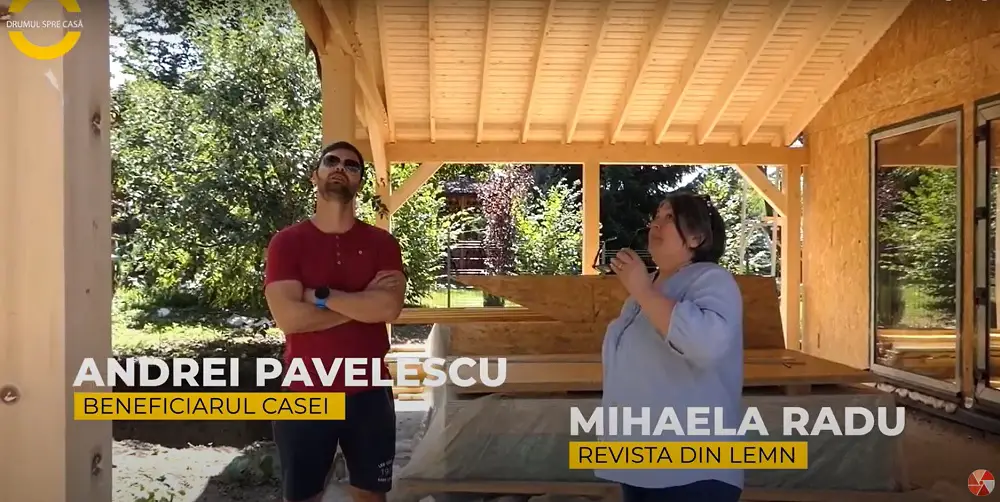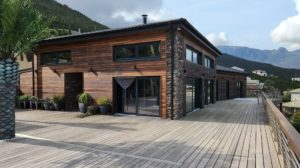The week, about whose adventures we've told here, started in Voinești to see the state of works on the House between the apple trees, a month after they started. They were, as one of the carpenters put it, 99% away from what needed to be done structurally. The house was fully erected, the roof had still to be tiled, the terraces were also finished, even if their design had been slightly modified in the meantime. At this stage, Andrei had decided to finish the terraces all by himself, which were made entirely of resinous wood.

The recently cut wood looked very nice and Andrei would have wanted it to stay that way, in its natural color, even if he was going to apply a treatment to protect it. And that's how we got to the discussion about finishing the resinous wood used outside and what would be the solutions in this case, which you can follow at the end of the article. As preserving the original color of resinous wood is impossible with ordinary finishes, I will expand on this topic, especially since many of those who write to me ask me the same question. And I will also tell you what solutions I have thought of to make the terrace as close as possible to what Andrei wants.
The color change of resinous wood starts immediately after cutting
The change in wood color after felling is not unique to resinous trees. Most species change their color on contact with light, but in some it is more noticeable, such as resinous and cherryand almost none at all in others (frasinIn resinous the color is constantly changing, with the wood turning an increasingly reddish-yellow as time passes. The only way to keep the color as close to its original color as possible is to protect it from light. The easiest way to see the color change is to leave a book for a longer period of time on a table's resin tabletop, finished with clear varnish. Underneath the book, the wood will be light in color, as it was originally, unlike the rest of the top, which will be darker, with a reddish-yellow tint.
Light, whether from the sun or from household lamps, acts on the substances in the wood and gradually breaks them down, giving rise to reddish-yellow dyes. This process can be slowed down by UV absorbers found in some varnishes, or by using lightly colored finishing materials - such as outdoor varnishes - which deflect the sun's rays, protecting the wood surface.
Color cannot be preserved, but can be reproduced
And what good is stain protection if we want natural wood in its original color? Use it, because that color can be very close to the wood's natural color. If it is a lightfast color - and in this case I recommend pigment-based staining solutions - it will hold over time, while also protecting the wood from oxidation that leads to color change. This is why pine colored stain is available for finishing resinous wood. It is very close to the wood's original color and does not change in the sun. Of course, the finish must be maintained and refinished periodically, at the intervals recommended by the manufacturer, so that the effect can be maintained.
The color change of resinous wood also occurs in interior wood and is sometimes accentuated by yellowing of the varnish. It is nitrocellulose varnishes that yellow the most. I recommend acrylic, water-based or solvent-based varnishes. They preserve the color of the finish over time.
To keep that whitish-yellow color of fresh-cut resinous wood you can make an artifice. You can use a diluted white bath or oil/varnish to which you have added 3-5% white pigment (titanium dioxide). If you use a diluted stain, it will not have the power, in one pass, to completely cover the wood. Instead, it will give a whitish tint and preserve the appearance of the wood's original color. The same effect can be achieved with varnish or oil to which white pigment has been added. Be careful, however, not to apply too many coats, as instead of enhancing the effect, you will get a paint-like coating. Apply one coat and let it dry completely to see the color. After drying, the effect fades and some of the whiteness disappears. Not so with subsequent coats. The layer of colored varnish is already placed on a substrate and in this case the white effect is amplified. If you have achieved the color you want, but want better protection, apply a colorless varnish or oil.
How I see the terrace of the house in Voinești
The back terrace of the House of the Apple Trees in Voinești is where I think there will be a lot of sitting. It's generous, quite hidden from view and open to the orchard of apple and walnut trees climbing up the hillside. It has posts of laminated beams of resinous wood, and the roof is clad on the inside with resinous wood. The entrance to the house is through two large glazed doors, continued on the left and right by a glazed wall. The frames of the glazed parts are colored wenge, and the house will be beige. Under these circumstances I think the posts and terrace guard would go to be stained walnut or venge, and the inside of the roof coated with white pigment and oil as in the examples above. The contrast will be pleasing, there won't be a lot of color, and the wood will appear to retain its original color.
Finishing can be done - for posts and guards - with walnut-colored oil-based varnish and the rest of the wood with a 1:1 mixture of white oil-based varnish and oil, so that the white does not stand out too much. I recommend the oil because it's easy to maintain and looks more natural.
I am curious to see what solution Andrei will choose for the terraces of the house. I'm sure he'll make a good choice and the house will look great in the end. Until then, watch episode 4, with the house almost ready a month after the footing has been laid on the foundation.




































Interesting article and solutions offered by Ms. M. Radu, a chemical engineer, I worked at Colorom and I would say I am a bit in the field.
Thank you!
I think we met at the Giurgiu Combine. Am I wrong?